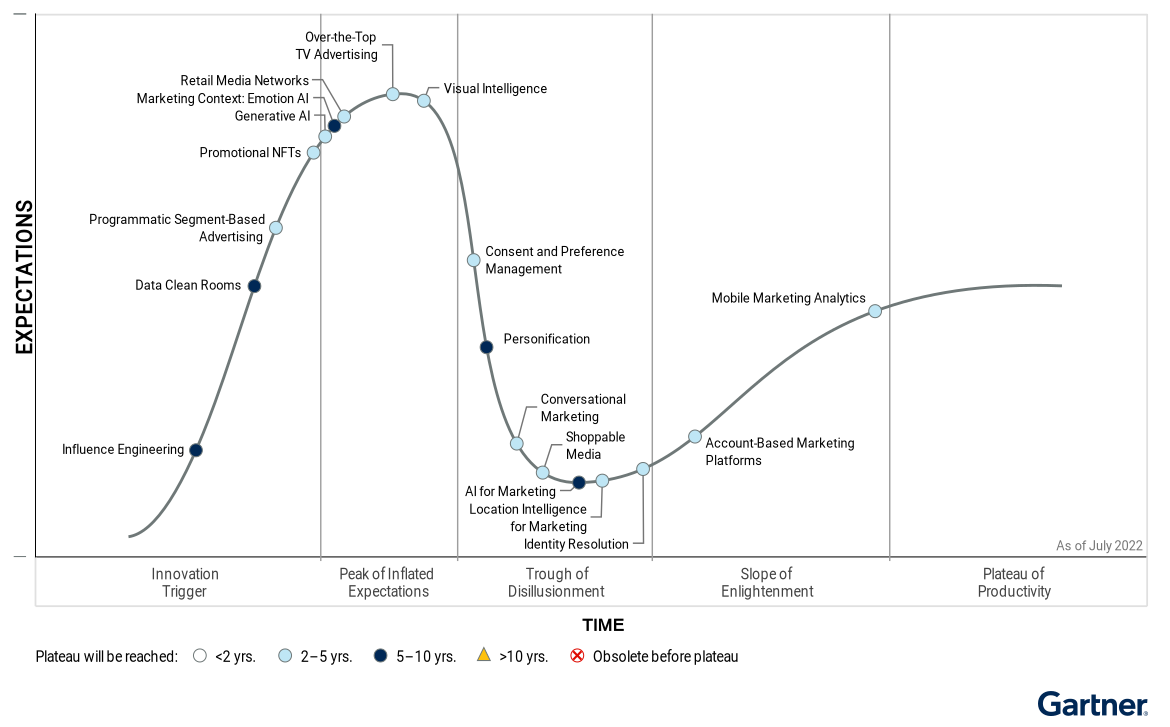Digital advertisers, here are 4 emerging tech to keep an eye on
The expanded role of artificial intelligence in advertising is expected within a decade, but privacy concerns may impede progress, says Gartner.

There are four emerging technologies on the 2022 Gartner, Inc. Hype Cycle for Digital Advertising that are expected to have a transformational impact on digital advertising: artificial intelligence (AI) for marketing, emotion AI, influence engineering, and generative AI.
The Gartner Hype Cycle provides a view of how a technology or application will evolve over time, providing a source of insight to manage its deployment within the context of a specific business goal. The Gartner Hype Cycle allows clients to get educated about the promise of an emerging technology within the context of their industry and individual appetite for risk.
“The accelerated fragmentation of digital media poses challenges to marketers in advertising, prompting them to assemble a roster of partners and technologies to optimize and grow advertising campaigns,” said Mike Froggatt, Senior Director Analyst in the Gartner Marketing practice. “In particular, the use of AI is expanding into targeting, measurement, identity resolution, and consent and preference management, and even in some advanced cases, generating creative content with generative AI tools.”
“Attention and investment dollars are also moving toward other emerging channels and technologies such as retail media networks, data clean rooms, promotional NFTs and over-the-top TV advertising, all nearing the Peak of Inflated Expectations (see Figure 1).”

AI for marketing
AI for marketing comprises systems that change a marketing platform’s behaviors without being explicitly programmed, based on data collected, usage analysis and other observations for marketing use cases. Enabling techniques include machine learning (ML), rule-based systems, optimization, natural language processing and knowledge graph techniques.
“The power of AI in marketing is clear as deepfakes, chatbots and metaverse avatars show their ability to synthesize lifelike experiences,” said Froggatt. “Likewise, the suppression of personal data for marketing alongside the rise of AI to assess contextual response anonymously is altering the data foundations of advertising and content marketing.”

There are three specific implementations of the technology that marketers are starting to use in novel ways – emotion AI, influence engineering and generative AI.
Emotion AI
Emotion AI technologies – also called affective computing – use AI techniques to analyze the emotional state of a user via computer vision, audio/voice input, sensors and/or software logic. It can initiate responses by performing specific, personalized actions to fit the mood of the customer. Emotion AI is considered transformational because it turns human behavioral attributes into data that has significant impact on all aspects of digital communication.

For marketers and advertisers, access to emotion data delivers insights into motivational drivers that help test and refine content, tailor digital experiences and build deeper connections between people and brands.
“It is not enough to deliver relevant and personalized messaging through ads via walled gardens, so CMOs are leaning on emotion AI to find and target consumers and business buyers at scale,” said Froggatt. “However, privacy concerns, bias and variation across modalities are the core obstacles to adoption among advertisers, which is why it may take another 10 years to become established.”
Influence engineering
Emotion AI is part of the larger trend of influence engineering, or the production of algorithms designed to automate elements of digital experience that guide user choices by learning and applying techniques of behavioral science.
As established personalization techniques wane under privacy restrictions, new data sources and ML capabilities are enabling new systems of influence. Breakthroughs in areas such as emotion detection, content generation and edge computing are automating influential aspects of communication, for better or worse.
Organizations need influence engineering as a new form of governance to oversee research and deployment of AI programs focused on affecting behavior at scale. Gartner anticipates the practice to become mainstream in five to 10 years.
Generative AI
Generative AI learns from existing artifacts to generate new, realistic artifacts such as video, narrative, speech, synthetic data and product designs that reflect the characteristics of the training data without repetition. It is expected to reach mainstream adoption in digital advertising in the next two to five years.
In the face of third-party data deprecation, generative AI can help to identify the core characteristics of customers and target them with custom content in a privacy-compliant way. It can also be used to train media buying models to avoid risky content like misinformation and deepfakes.
“Marketing leaders can demonstrate the value of advertising by assessing the viability of these technologies at their organizations and within the context of recessionary pressures,” said Froggatt.
Save time and money when creating and distributing high-quality content for branding and marketing with ContentGrow. Sign up to get your campaign started or book a quick call with our team to learn more.




